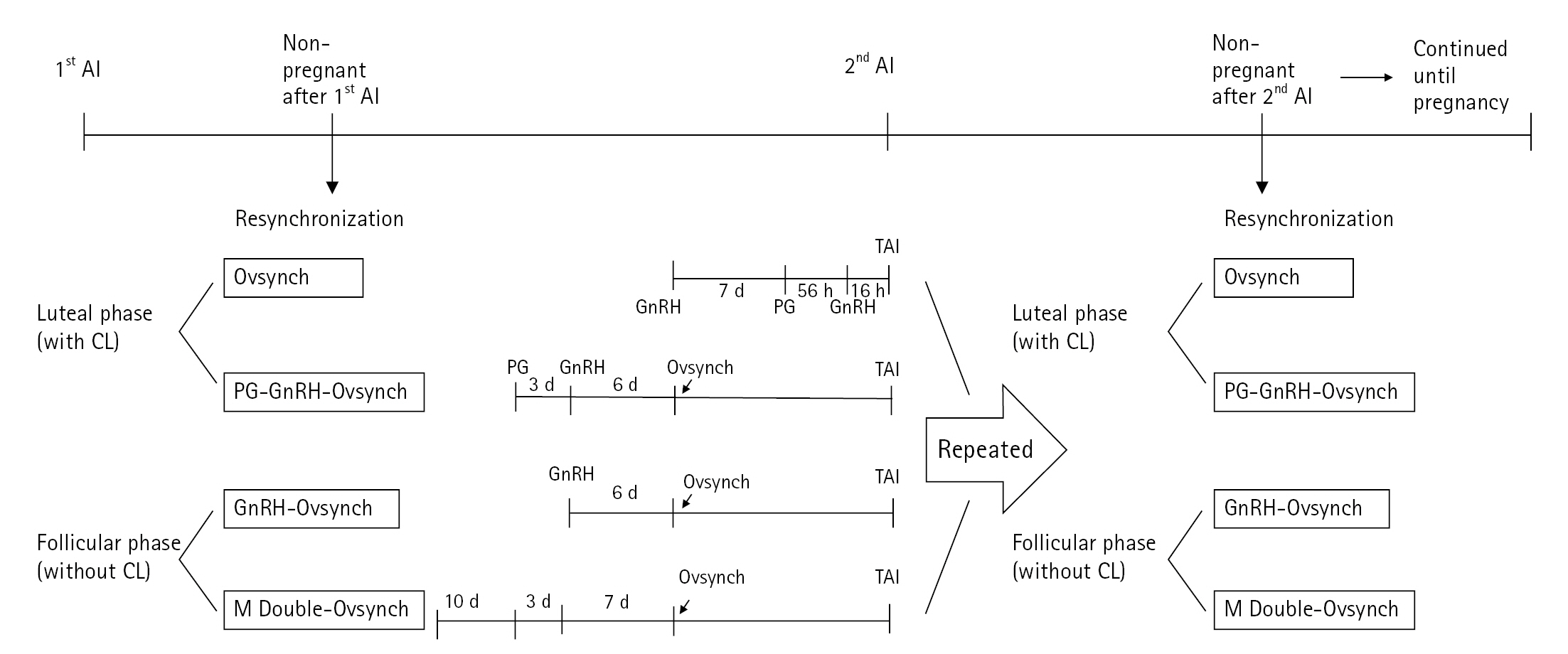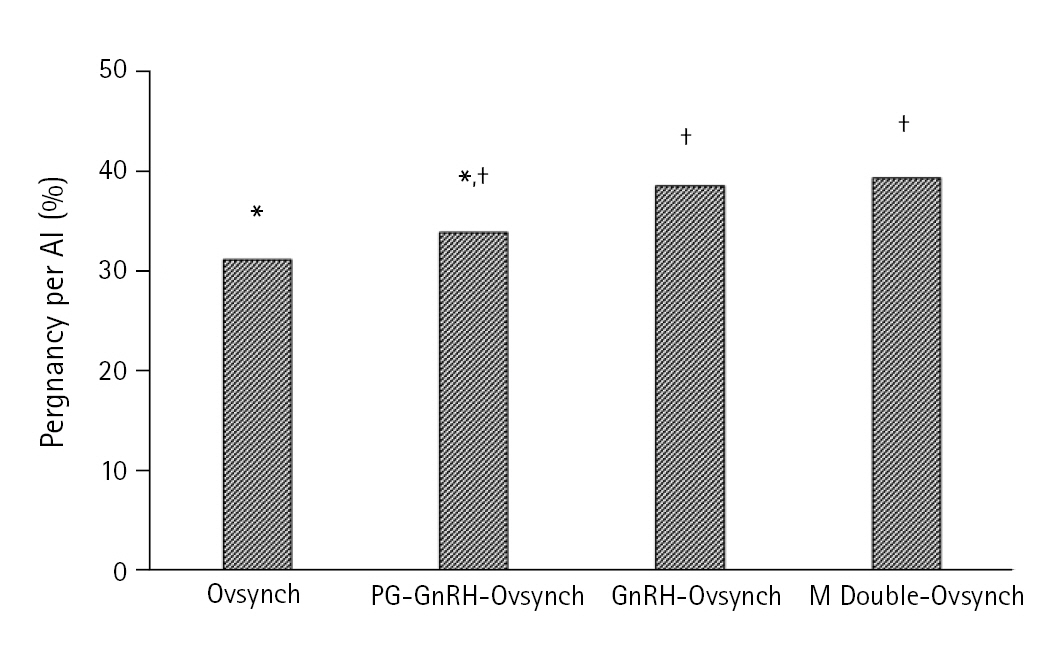 |
 |
| Korean J Vet Res > Volume 63(2); 2023 > Article |
|
Abstract
This study evaluated the effect of resynchronization programs on pregnancies in dairy cows. Of 1,342 cows confirmed not pregnant after their first artificial insemination (AI), those with a corpus luteum (CL) were resynchronized using Ovsynch or PG-GnRH-Ovsynch and those without a CL were resynchronized using GnRH-Ovsynch or modified Double-Ovsynch. There were no differences (p > 0.05) in the pregnancies per AI either between the Ovsynch (31.3%) and PG-GnRH-Ovsynch (34.0%) or between the GnRH-Ovsynch (38.7%) and modified Double-Ovsynch (39.5%). In conclusion, Ovsynch and GnRH-Ovsynch programs could be preferred to resynchronize cows with and without a CL, respectively, from the perspective of reducing costs and labor.
Increase in the herd size and continuous the milk yield makes it difficult to observe estrus in dairy cows. This is one of the main reasons for a decrease in reproductive performance [1]. This has necessitated widespread adoption of hormonal synchronization protocols that allow for timed artificial insemination (AI). When a cow does not become pregnant after AI, immediate implementing a resynchronization program at the time of the nonpregnancy diagnosis may shorten the interval to the next insemination in fields [2,3]. The Ovsynch program, which consists of an injection of gonadotropin-releasing hormone (GnRH), prostaglandin PGF2╬▒ (PG) 7 days later, 2nd GnRH 56 hours later, followed by timed AI (TAI) 16 hours later, is one of the most widely used programs for resynchronization in dairy cows [4,5]. It has been reported that cows with a corpus luteum (CL) before the initiation of Ovsynch had a higher pregnancy per AI than cows without a CL [6]. Furthermore, initiation of Ovsynch during early diestrus (5 to 9 days of the estrus cycle) has been reported to increase the pregnancies per AI [7]. Thus, various reproductive programs such as Ovsynch, modified Ovsynch, or Double-Ovsynch, which consists of an Ovsynch, followed 7 days later by another Ovsynch, have been used for resynchronization [8-10]. However, cows that did not become pregnant after AI may not be in the same phase of the estrus cycle and could be in the follicular or luteal phase. The primary aim of this study was to select more effective resynchronization programs depending on the presence or absence of a CL in the ovaries of non-pregnant cows, which would lead to an improvement in reproductive performance. Therefore, this study compared the pregnancy outcomes following the Ovsynch or PG-GnRH-Ovsynch programs to resynchronize the cows with a CL, and GnRH-Ovsynch or Double-Ovsynch programs to resynchronize the cows without a CL.
The study was conducted on 20 dairy farms in Chungcheong Province. Each farm had between 40 and 250 cows, which were maintained in loose housing systems, fed total mixed rations, and milked twice daily. All cows in the participating farms underwent reproductive health checks every 2 weeks. These included an examination of their ovarian structures (follicle and CL) and uterus by transrectal palpation and ultrasonography. The voluntary waiting period from calving to the first AI was 50 days.
Of 1,342 dairy cows confirmed to be not pregnant by ultrasonography 30 days after the first AI after calving, cows with a CL were resynchronized as follows: (1) Ovsynch, which consisted of a 10 ┬Ąg of a GnRH analog, buserelin acetate (Gestar; Over, Argentina), followed by 500 ╬╝g of a PG analog, cloprostenol sodium (Estrumate; MSD Animal Health, Korea) after 7 days, a second injection of GnRH 56 hours later, and TAI 16 hours later (Ovsynch, n = 632) or (2) An injection of PG, GnRH 3 days later, followed by Ovsynch 6 days later (PG-GnRH-Ovsynch, n = 191). Cows without a CL were resynchronized as follows: (3) An injection of GnRH, followed by Ovsynch 6 days later (GnRH-Ovsynch, n = 256) or (4) An injection of GnRH, PG 10 days later, GnRH 3 days later, followed by Ovsynch 7 days later (modified Double-Ovsynch, n = 263). Fig. 1 shows a schematic diagram showing repeated resynchronizations, in which 4 resynchronization programs were implemented according to the ovarian status in dairy cows. Pregnancy was evaluated 30 and 45 days after the AI. Cows confirmed as not being pregnant by ultrasonography were resynchronized using the resynchronization programs and this was continued until the cows became pregnant or were culled. The pregnancies per AI following repeated resynchronizations between the Ovsynch, PG-GnRH-Ovsynch, GnRH-Ovsynch, and Double-Ovsynch groups were compared using the chi-square test. A p-value < 0.05 was considered statistically significant.
The 1,342 cows included in this study had a mean parity of 2.1 ┬▒ 1.3 (┬▒ standard deviation). The mean interval between the initiation of each reproductive program and TAI was 10 (┬▒ 0.9), 19 (┬▒ 0.9), 16 (┬▒ 1.0), and 30 (┬▒ 1.3) days in the Ovsynch, PG-GnRH-Ovsynch, GnRH-Ovsynch, and Double-Ovsynch groups, respectively. The pregnancies per AI after the second, third, fourth, or Ōēź fifth inseminations were 35.1% (236/673), 34.9% (119/341), 36.2% (59/163), and 31.5% (52/165), respectively. Pregnancies per AI following the Ovsynch, PG-GnRH-Ovsynch, GnRH-Ovsynch, or Double-Ovsynch were 31.3%, 34.0%, 38.7%, and 39.5%, respectively. Therefore, the pregnancies per AI in the GnRH-Ovsynch and Double-Ovsynch groups were higher (p < 0.05) than those in the Ovsynch group (Fig. 2). However, there were no differences (p>0.05) in the pregnancies per AI either between the Ovsynch and PG-GnRH-Ovsynch or between the GnRH-Ovsynch and modified Double-Ovsynch (Fig. 2).
Our findings regarding the higher pregnancies per AI in the GnRH-Ovsynch and modified Double-Ovsynch groups compared to the Ovsynch group are consistent with a previous study [9], and this could be due to increased synchronization of cows during the Ovsynch program before TAI by way of the presynchronization with a single GnRH or an Ovsynch. However, unlike our findings, earlier studies found no beneficial effect of the presynchronization with GnRH before Ovsynch or CO-Synch, which consists of an injection of GnRH, PG 7 days later, followed by 2nd GnRH and concurrent TAI 72 hours later, on the pregnancies per AI in resynchronized dairy cows [8,11,12]. The reason for the difference between our study and others is not known, but it could be mainly because the cows were randomly grouped without checking for the presence of a CL in their ovaries in the earlier studies [8,11,12]. In cows with a CL, we found no benefit of the presynchronization with PG and GnRH before Ovsynch compared to the Ovsynch group that received no presynchronization. We expected that presynchronization with PG and GnRH before Ovsynch would improve the pregnancies per AI compared to only Ovsynch through more systematic follicular wave emergence, follicular development, and ovulation. However, our findings were not in sync with our expectations. Contrary to our findings, a previous study found that a presynchronization with PG and GnRH led to a greater ovulatory and luteolytic response to the first GnRH and PG of Ovsynch, resulting in a tendency toward a higher pregnancy per AI [13]. This discrepancy between studies highlights the need for further research to identify the reasons for the same. In addition, the development of a better resynchronization program that can improve the fertility in cows with a CL might be required and could be the subject of future study.
In conclusion, our results show that the addition of presynchronization with a single GnRH or an Ovsynch before the Ovsynch for resynchronization in cows without a CL improves the pregnancy per AI compared to the only Ovsynch program in cows with a CL. However, we found no differences in the pregnancies per AI either between the Ovsynch and PG-GnRH-Ovsynch programs in cows with a CL or between the GnRH-Ovsynch and modified Double-Ovsynch programs in cows without a CL. Therefore, it is recommended that the Ovsynch and GnRH-Ovsynch programs could be preferred to resynchronize cows with and without a CL, respectively, from the perspective of reducing medication costs and saving labor.
Fig.┬Ā1.
A schematic diagram showing repeated resynchronizations, in which 4 resynchronization programs were implemented according to the ovarian status of dairy cows. AI, artificial insemination; CL, corpus luteum; d, day; GnRH, gonadotropin-releasing hormone; PG, prostaglandin F2╬▒; M Double-Ovsynch, modified Double-Ovsynch. Resynchronization: (1) Ovsynch, which consists of a GnRH injection, followed 7 days later by PG, a second injection of GnRH 56 hours later, and timed AI (TAI) 72 hours later (Ovsynch, n = 632); (2) an injection of PG, GnRH 3 days later, followed by Ovsynch 6 days later (PG-GnRH-Ovsynch, n = 191); (3) an injection of GnRH, followed by Ovsynch 6 days later (GnRH6-Ovsynch, n = 256); or (4) an injection of GnRH, PG 10 days later, GnRH 3 days later, followed by Ovsynch 7 days later (modified Double-Ovsynch, n = 263).

References
1. Reith S, Hoy S. Review: behavioral signs of estrus and the potential of fully automated systems for detection of estrus in dairy cattle. Animal 2018;12:398-407.


2. Sterry RA, Welle ML, Fricke PM. Effect of interval from timed artificial insemination to initiation of resynchronization of ovulation on fertility of lactating dairy cows. J Dairy Sci 2006;89:2099-2109.


3. Wijma R, P├®rez MM, Masello M, Stangaferro ML, Giordano JO. A resynchronization of ovulation program based on ovarian structures present at nonpregnancy diagnosis reduced time to pregnancy in lactating dairy cows. J Dairy Sci 2018;101:1697-1707.


4. Dewey ST, Mendon├¦a LG, Lopes G Jr, Rivera FA, Guagnini F, Chebel RC, Bilby TR. Resynchronization strategies to improve fertility in lactating dairy cows utilizing a presynchronization injection of GnRH or supplemental progesterone: I. Pregnancy rates and ovarian responses. J Dairy Sci 2010;93:4086-4095.


5. Sinedino LD, Lima FS, Bisinotto RS, Cerri RL, Santos JE. Effect of early or late resynchronization based on different methods of pregnancy diagnosis on reproductive performance of dairy cows. J Dairy Sci 2014;97:4932-4941.


6. Herlihy MM, Crowe MA, Berry DP, Diskin MG, Butler ST. Factors associated with fertility outcomes in cows treated with protocols to synchronize estrus and ovulation in seasonal-calving, pasture-based dairy production systems. J Dairy Sci 2013;96:1485-1498.


7. Vasconcelos JL, Silcox RW, Rosa GJ, Pursley JR, Wiltbank MC. Synchronization rate, size of the ovulatory follicle, and pregnancy rate after synchronization of ovulation beginning on different days of the estrous cycle in lactating dairy cows. Theriogenology 1999;52:1067-1078.


8. Carvalho PD, Fuenzalida MJ, Ricci A, Souza AH, Barletta RV, Wiltbank MC, Fricke PM. Modifications to Ovsynch improve fertility during resynchronization: Evaluation of presynchronization with gonadotropin-releasing hormone 6 d before initiation of Ovsynch and addition of a second prostaglandin F2╬▒ treatment. J Dairy Sci 2015;98:8741-8752.


9. Giordano JO, Wiltbank MC, Guenther JN, Pawlisch R, Bas S, Cunha AP, Fricke PM. Increased fertility in lactating dairy cows resynchronized with Double-Ovsynch compared with Ovsynch initiated 32 d after timed artificial insemination. J Dairy Sci 2012;95:639-653.


10. Spencer JA, Carnahan K, Shafii B, Price WJ, Dalton J, Ahmadzadeh A. Pregnancy outcomes are not improved by administering gonadotropin-releasing hormone at initiation of a 5-day CIDR-Cosynch resynchronization protocol for lactating dairy cows. J Dairy Sci 2018;101:8524-8531.


11. Bruno RG, Moraes JG, Hern├Īndez-Rivera JA, Lager KJ, Silva PR, Scanavez AL, Mendon├¦a LG, Chebel RC, Bilby TR. Effect of an Ovsynch56 protocol initiated at different intervals after insemination with or without a presynchronizing injection of gonadotropin-releasing hormone on fertility in lactating dairy cows. J Dairy Sci 2014;97:185-194.


- TOOLS
-
METRICS

-
- 0 Crossref
- 0 Scopus
- 1,002 View
- 58 Download
- ORCID iDs
-
Jaekwan Jeong

https://orcid.org/0000-0002-8379-3194Uihyung Kim

https://orcid.org/0000-0002-2197-5080Illhwa Kim

https://orcid.org/0000-0002-2092-0264 - Related articles



 PDF Links
PDF Links PubReader
PubReader ePub Link
ePub Link Full text via DOI
Full text via DOI Download Citation
Download Citation Print
Print



